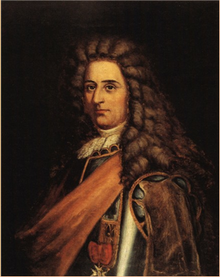
Jacques Testard de Montigny (1663–1737) was an officer in the French Marines in Canada.

Jacques Testard de Montigny (1663–1737) was an officer in the French Marines in Canada.
Born in Montreal into a merchant family, Montigny first saw military action as a volunteer on the expedition against Schenectady in 1690. Two years later he went to France with Pierre Le Moyne d'Iberville, and was in 1693 stationed the capital of Acadia, Fort Nashwaak, where he led the local Abenaki and Mi'kmaq in raids against the English (See Battle of Fundy Bay.)While posted there he also engaged in trade and commerce, sometimes in conflict with his military duties.

Montreal is the most populous municipality in the Canadian province of Quebec and the second-most populous municipality in Canada. Originally called Ville-Marie, or "City of Mary", it is named after Mount Royal, the triple-peaked hill in the heart of the city. The city is centred on the Island of Montreal, which took its name from the same source as the city, and a few much smaller peripheral islands, the largest of which is Île Bizard. It has a distinct four-season continental climate with warm to hot summers and cold, snowy winters.

The Schenectady Massacre was an attack against the village of Schenectady in the colony of New York on 8 February 1690. A party of more than 200 Canadians and allied Mohawk and Algonquin warriors attacked the unguarded community, destroying most of the homes, and killing or capturing most of its inhabitants. Sixty residents were killed, including 11 enslaved Africans. About 60 residents were spared, including 20 Mohawk.

France, officially the French Republic, is a country whose territory consists of metropolitan France in Western Europe and several overseas regions and territories. The metropolitan area of France extends from the Mediterranean Sea to the English Channel and the North Sea, and from the Rhine to the Atlantic Ocean. It is bordered by Belgium, Luxembourg and Germany to the northeast, Switzerland and Italy to the east, and Andorra and Spain to the south. The overseas territories include French Guiana in South America and several islands in the Atlantic, Pacific and Indian oceans. The country's 18 integral regions span a combined area of 643,801 square kilometres (248,573 sq mi) and a total population of 67.3 million. France, a sovereign state, is a unitary semi-presidential republic with its capital in Paris, the country's largest city and main cultural and commercial centre. Other major urban areas include Lyon, Marseille, Toulouse, Bordeaux, Lille and Nice.
In 1696 Montigny was on d'Iberville's expedition against Pemaquid, an English fort on the northern frontier with Acadia. In this action he began a close association with the Abenaki war leader Escumbuit, who also joined Montigny on d'Iberville's Newfoundland campaign later in 1696, in which most of the English settlements on Newfoundland were destroyed. Montigny was given an independent command by d'Iberville, in which he traveled along the coast, destroying settlements and fishing stages as he went. Despite the destructive nature of the expedition, it had no long-lasting implications, as the English quickly returned, rebuilding and fortifying some of the settlements.

The Siege of Pemaquid occurred during King William's War when French and Native forces from New France attacked the English settlement at Pemaquid, a community on the border with Acadia. The siege was led by Pierre Le Moyne d'Iberville and Baron de St Castin between August 14–15, 1696. Commander of Fort William Henry, Captain Pasco Chubb, surrendered the fort. Iberville killed three of the soldiers and sent the other 92 back to Boston.

The Avalon Peninsula Campaign occurred during King William's War when forces of New France, led by Pierre Le Moyne d'Iberville and Governor Jacques-François de Monbeton de Brouillan, destroyed 23 English settlements along the coast of the Avalon Peninsula, Newfoundland in the span of three months. The campaign began with raiding Ferryland on November 10, 1696 and continued along the coast until they raided the village of Heart's Content
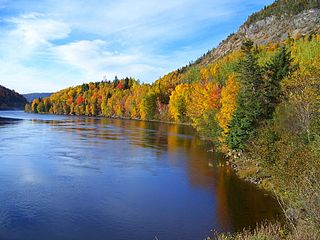
Newfoundland is a large Canadian island off the east coast of the North American mainland, and the most populous part of the Canadian province of Newfoundland and Labrador. It has 29 percent of the province's land area. The island is separated from the Labrador Peninsula by the Strait of Belle Isle and from Cape Breton Island by the Cabot Strait. It blocks the mouth of the Saint Lawrence River, creating the Gulf of Saint Lawrence, the world's largest estuary. Newfoundland's nearest neighbour is the French overseas community of Saint-Pierre and Miquelon.
Montigny was promoted to lieutenant in 1700. In 1704 he was sent back to Acadia, where he helped orchestrate raids against English settlements, and worked to convince the Abenakis to resettle closer to French settlements. In the winter of 1704/5 he brought a band of Abenakis to Newfoundland, where they attempted to repeated d'Iberville's 1696 expedition under the direction of Daniel d'Auger de Subercase. They once again destroyed a number of English settlements, but were unable to capture St. John's, the English capital.
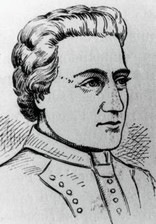
Daniel d'Auger de Subercase naval officer and French governor of Newfoundland and later Acadia, born Orthez, Béarn died Cannes-Écluse, Île-de-France. Subercase was baptised a Protestant to Jean Dauger, a rich merchant and bourgeois who had purchased several noble estates, including the lay abbey of Subercase, near Asson.

The Siege of St. John's was a failed attempt by French forces led by Daniel d'Auger de Subercase to take the fort at St. John's, Newfoundland during the winter months of 1705, in Queen Anne's War. Leading a mixed force of regulars, militia, and Indians, Subercase burned much of the town and laid an ineffectual siege against the fort for five weeks between late January and early March 1705. Subercase lifted the siege after running out of provisions and gunpowder.
In 1706 Montigny went to France with Escumbuit, where they were received by King Louis XIV. He was a member of an expedition sent in 1709 to dispute a possible English advance on Lake Champlain. The English never reached beyond the southern end of the lake, and the only action was a brief skirmish near Crown Point. He was awarded the Order of Saint Louis in 1712, and in 1721 was given command of a frontier fort on Green Bay, where he maintained good relations with the Fox, and was visited by his friend Escumbuit. By 1726 he had returned to Montreal, and in 1730 he was made commandant of Fort Michilimackinac, a post he held for three years before finally retiring.

Louis XIV, known as Louis the Great or the Sun King, was a monarch of the House of Bourbon who reigned as King of France from 1643 until his death in 1715. Starting on 14 May 1643 when Louis was 4 years old, his reign of 72 years and 110 days is the longest recorded of any monarch of a sovereign country in European history. In the age of absolutism in Europe, Louis XIV's France was a leader in the growing centralisation of power.

Lake Champlain is a natural freshwater lake in North America mainly within the borders of the United States but partially situated across the Canada–U.S. border, in the Canadian province of Quebec.

Crown Point is a town in Essex County, New York, United States, located on the west shore of Lake Champlain. The population was 2,024 at the 2010 census. The name of the town is a direct translation of the original French name, "Pointe à la Chevelure".
He died in Montreal in 1737. He was twice married, and had seven children.
Casimir-Amable Testard de Montigny was a businessman and politician in Quebec. He represented Effingham in the Legislative Assembly of Lower Canada from 1824 to 1827.

Nova Scotia is a Canadian province located in Canada's Maritimes. The region was initially occupied by Mi'kmaq. During the first 150 years of European settlement, the colony was primarily made up of Catholic Acadians, Maliseet and Mi'kmaq. During the latter seventy-five years of this time period, there were six colonial wars that took place in Nova Scotia. After agreeing to several peace treaties, this long period of warfare ended with the Burial of the Hatchet Ceremony between the British and the Mi'kmaq (1761) and two years later when the British defeated the French in North America (1763). During these wars, Acadians, Mi'kmaq and Maliseet from the region fought to protect the border of Acadia from New England. They fought the war on two fronts: the southern border of Acadia, which New France defined as the Kennebec River in southern Maine. The other front was in Nova Scotia and involved preventing New Englanders from taking the capital of Acadia, Port Royal, establishing themselves at Canso.

Queen Anne's War (1702–1713) was the second in a series of French and Indian Wars fought in England's Thirteen American Colonies; in Europe, it is viewed as the North American theater of the War of the Spanish Succession. It was fought between France and England for control of the American continent, while the War of the Spanish Succession was primarily fought in Europe. The war also involved numerous American Indian tribes allied with each nation, and Spain was allied with France. It is also known as the Third Indian War or in France as the Second Intercolonial War. It was fought on three fronts:

King William's War was the North American theater of the Nine Years' War (1688–97), also known as the War of the Grand Alliance or the War of the League of Augsburg. It was the first of six colonial wars fought between New France and New England along with their respective Native allies before France ceded its remaining mainland territories in North America east of the Mississippi River in 1763.
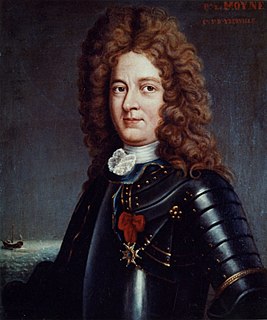
Pierre Le Moyne d'Iberville was a soldier, ship captain, explorer, colonial administrator, knight of the order of Saint-Louis, adventurer, privateer, trader, member of Compagnies Franches de la Marine and founder of the French colony of La Louisiane of New France. He was born in Montreal of French colonist parents.

This section of the Timeline of Quebec history concerns the events relating to the Quebec portion of New France between the establishment of the Sovereign Council and the fall of Quebec.

Philippe Pastour de Costebelle was a naval officer and Governor of Newfoundland, born in Languedoc and died in Louisbourg.
Jacques-François de Monbeton de Brouillan French military officer and Governor of Plaisance (Placentia), Newfoundland (1689-1701) and Acadia (1701-1705).
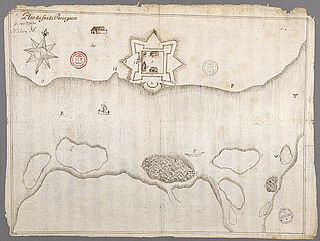
Fort Pentagouët was a French fort established in present-day Castine, Maine, which was the capital of Acadia (1670–1674). It is the oldest permanent settlement in New England.
Jean Baudoin (1662–1698) was a French Sulpician priest who served as a missionary in Acadia, and later as a chaplain during military expeditions carried on by Pierre Le Moyne d'Iberville.
Pierre Maisonnat dit Baptiste was a French privateer famous for the success he had against New England merchant shipping and fishing interests during King William's War and Queen Anne's War. Baptiste's crew members were primarily Acadians.

The Raid on Grand Pré was the major action of a raiding expedition conducted by New England militia Colonel Benjamin Church against French Acadia in June 1704, during Queen Anne's War. The expedition was in retaliation for a French and Indian raid against the Massachusetts frontier community of Deerfield earlier that year.

Jean-Baptiste Hertel de Rouville was a colonial military officer of New France in the French Marines in Canada. He is best known in North America for leading the raid on Deerfield, in western Province of Massachusetts Bay, against English settlers on 29 February 1704. A dedicated soldier, he was widely reviled by the settlers of New England for his tactics of raiding poorly defended frontier settlements. During Queen Anne's War he also participated in military operations against the English in Newfoundland. He played a role in the early settlement of Île-Royale, after that war.

The Raid on Haverhill was a military engagement that took place on August 29, 1708 during Queen Anne's War. French, Algonquin, and Abenaki warriors under the command of Jean-Baptiste Hertel de Rouville descended on Haverhill, then a small frontier community in the Province of Massachusetts Bay. In the surprise attack, 16 people were killed and another 14 to 24 were taken captive. A rapid militia muster gave chase, and in a skirmish later in the day, nine of the French and Indian party were killed and some of their prisoners escaped.

The Naval battle off St. John took place on July 14, 1696, between France and England toward the end of King William's War in the Bay of Fundy off present-day Saint John, New Brunswick. The English ships were sent from Boston to interrupt the supplies being taken by French officer Pierre Le Moyne d'Iberville from Quebec to the capital of Acadia, Fort Nashwaak on the Saint John River. The French ships of war Envieux and Profond captured the English frigate Newport, while the English frigate Sorlings and a provincial tender escaped.
The Northeast Coast campaign was the first major campaign of Queen Anne's War in New England. Alexandre Leneuf de La Vallière de Beaubassin led 500 troops made up of French colonial forces and the Wabanaki Confederacy of Acadia. They attacked English settlements on the coast of present-day Maine between Wells and Casco Bay, burning more than 15 leagues of New England country and killing or capturing more than 150 people. The English colonists were able to protect some of their settlements, but a number of others were destroyed and abandoned. Historian Samuel Drake reported that, "Maine had nearly received her death-blow" as a result of the campaign.
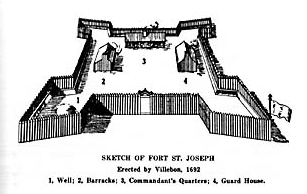
Fort Nashwaak was the capital of Acadia and is now a National Historic Site of Canada in present-day Fredericton, New Brunswick, Canada. It was located strategically up the Saint John River and close to the native village Fort Meductic for military purposes.
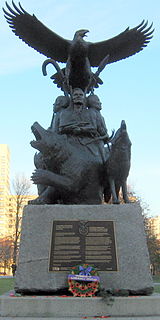
The Maliseet militia were made up of warriors from the Maliseet people of northeastern North America. Along with the Wabanaki Confederacy, the French and Acadian militia, the Maliseet fought the British through six wars over a period of 75 years. They also mobilized against the British in the American Revolution. After confederation, Mi'kmaq warriors eventually joined Canada's war efforts in World War I and World War II.
Not to be confused with the Battle of Falmouth (1690)